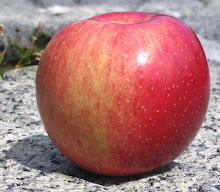This antique variety (more than 200 years old) is beloved, even legendary. It has a wonderful name, at once old (think Nodhead or Hubbardston Nonesuch) and new (Honeycrisp, Jazz).

|
I have never tasted one before, so you can imagine my keen interest.
I am holding a large, classically shaped apple with a red blush, both saturated and streaky, over yellow green, a little on the dull side. Light lenticels, mostly at the bottom, decorate the blush; they are barely visible elsewhere.
There's some ribbing and, on my sample, flyspeck. Its calyx is closed, but not tightly, and it sits firm in my hand, with a faint cidery aroma.
Tasting the sap
Biting into this apple for the first time reveals dense white flesh with a faint yellow cast, medium-fine grained and crunchy crisp.
Winesap's flavor is surprisingly mild, neither tart nor sweet. Perhaps this why I am able to notice a nutty taste, though it is not a strong flavor.
There is a hint of vinous clarity and fruit flavors at the start of each bite, followed by a kind of roasted flavor that is almost savory—what the Japanese call umami.
Finally the thick peel dominates the finish, emphasizing the darker, almost vegetable tastes.
After the finish a kind of savoriness remains. The wine in this Winesap is surely a hearty red.
At the same time, this is not at all a heavy apple. Indeed, the wonderful contrast between the crisp, McIntosh-like texture and these faint roast-grain flavors is one of the things that makes this a great and distinctive apple.
 The name Winesap is from wine
sop, bread dipped in wine.
The name Winesap is from wine
sop, bread dipped in wine.
My usual approach, as in this case, is to taste and describe an apple without reference to other descriptions. Only when I have written my impressions will I fire up the old search engine and see what else there is to know (always learning something).
That research led me to descriptions of Winesap that disagreed so markedly
from my experience (and sometimes from each other) as to make me at least
question the classification.
It does not help that there are other varieties with "Winesap" in the name,
but I can say for certain that this is not the Stayman Winesap (also known
as Stayman), which I
reviewed last year
and which has a different appearance and taste.
If you know a different Winesap, perhaps the medium-sized fruit with yellow flesh that is sometimes tinged with red, I would be interested in hearing from you about it.
In the mean time, I trust the grower who sold me this fruit under this name. I also note that the photographs of Winesap in the National Fruit Collection (UK) are a nearly perfect match for what I have. (And NFC says another name for Winesap is "Potpie Apple"—is that the savory quality I noticed?)
Update: Winesap is sometimes confused with Stayman. These may be related, but they are not the same.
Also, The UK National Fruit Collection recently decided that Winesap is actually a much younger Irish apple called Bloody Butcher.
I doubt that very much, and think the NFC got their samples crossed. However, the listing I quote above is no longer available.

I'm just starting a small home orchard (15 trees so far) in Tennessee and have some varieties of winesap. The only one that has produced so far (3 yr old semidwarf) is Kinnaird's Choice. I purchased these trees from Century Farm Orchards (link below). I have the original Winesap, the "Old fashioned" Winesap (Red Winter), Stayman, and a couple of other sons of winesap: Blacktwig, Arkansas Black, and Kinnaird’s Choice.
ReplyDeleteI read your nice review of Ark Black - no matter how many I buy they never last long enough to mellow. Hard, as they say, as a rock.
http://www.centuryfarmorchards.com/descripts/osapage3.html
Mark
Mark, I am jealous of your Winesap collection.
ReplyDeleteCentury Farm Orchards has some nice photos at that link you provide. It really is marvelous to think of a whole different universe of apples prospering below the Mason-Dixon. Their Winesaps are here.
Good luck with your orchard, and thanks for dropping by!
I have one tree of what I think is a Winesap on my place, and it fits your descrition perfectly. My father said that this place used to be an apple orchard when he was a boy (in the 1930's), so we have a lot of old apple trees on the property - some of them I have had to cut down, as they are deteriorating, and we had too many of them. This one in a good year produces a very good cider - we made about 30 gallons last Saturday, about 2/3rds of the apples we used came from this tree. The birds, including a pair of pileated woodpeckers, enjoy the ones that I can't get to!
ReplyDeleteBirds and apples have quite a history. The famous Baldwin apple was originally known as "Peckers" for the woodpeckers that worried the mother tree.
DeleteI concur with your take on the roasty undertones and vegetal zing in the skin. A friend has what I think is an old-style Winesap, and mature. It takes all afternoon to strip this tree. Even though I thin the fruit heavily in June most of the apples turn out to be medium-small. But the flavor! They keep in cellar until May, and keep shape when cooked: chunky apple sauce and fabulous pies/tarts. If I ever get a cider press...
ReplyDeleteI wish I had a few about now! Did not see any this year.
DeleteBTW, I wonder if what you sampled above was a Stayman - a seedling of Winesap, and often called Stayman Winesap, piggy-backing on the wonderful rep of Winesap. Stayman, Out West, is a shadow of the taste and color, come to think of it, of its seed parent. Winesap averages medium to small, deeply red - often red on red with a bit of yellow if well shaded, and its flesh is golden to almost tawny. The flavor is tart, rich, wine? I'd go with Malbec for comparison. More apples are needed for a pie than with many other cultivars, and they stiffly hold their shape, even when stored 5 months before baking. But so worth it! My favorite apple ever since childhood (and I like a wide range.)
DeleteSutton's Farm at Stanthorpe, Queensland, Australia has Winesaps that accord with your description. The fruit I picked were very large, and more dark red. Lovely apple, but I have not found any Winesap trees for sale that match the fruit.
ReplyDeleteThanks, super one! I do not feel I have exhaustively cataloged all the Winesaps and Winesap pretenders, but I am comfortable that when I tasted this apple I had the real deal.
DeleteI like to buy the Stayman Winesap for pies and to mix with other apples for Apple Pies. Enjoyed your blog.
ReplyDeleteWinesaps can do vary from year to year. It was wet in September in NW NC. This resulted in very juicy/watery and somewhat mealy apples. Size is all over the map. Some this year were the size of grapefruit. It took a while (10 years )for the tree (M-111), but now this tree is a workhorse producing about 10 bushels a year.
ReplyDeletecrunchy mmmmmmmm
ReplyDelete